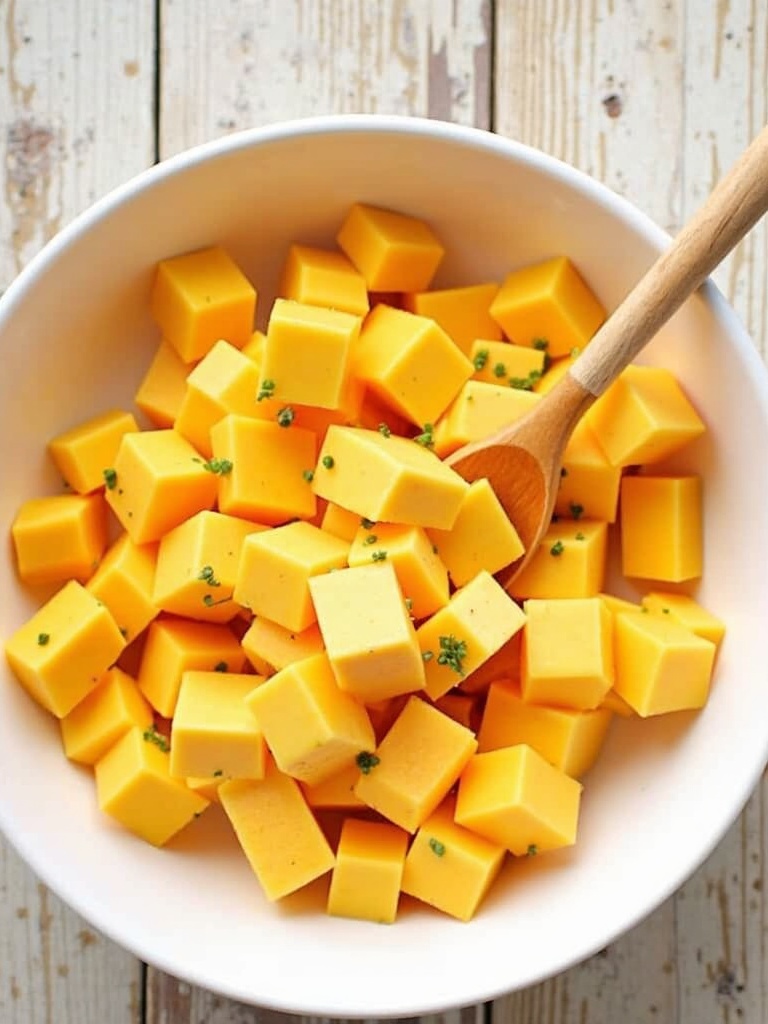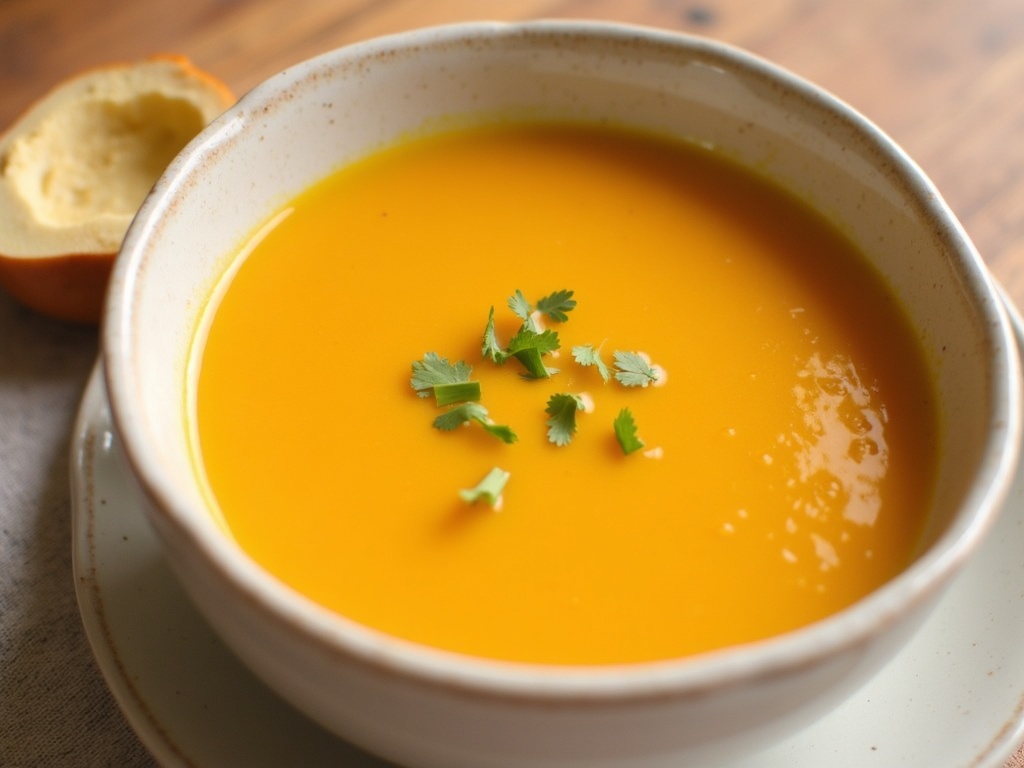Find In This Article
Introduction
There’s something magical about a steaming bowl of butternut squash soup on a chilly day. This velvety, golden elixir combines the sweet earthiness of butternut squash with warm spices to create pure comfort in liquid form. I’ve spent years perfecting this recipe, and I’m excited to share my ultimate version with you today.
What Ingredients are needed for Butternut Squash Soup?

To create this velvety butternut squash soup, you’ll need:
- 1 large butternut squash (about 3 pounds), peeled, seeded, and cubed
- 2 tablespoons olive oil
- 1 medium onion, chopped
- 2 carrots, peeled and chopped
- 2 celery stalks, chopped
- 3 garlic cloves, minced
- 1 tablespoon fresh ginger, grated
- 1 teaspoon ground cinnamon
- 1/4 teaspoon nutmeg
- 4 cups vegetable broth (or chicken broth for non-vegetarians)
- 1/2 cup coconut milk (or heavy cream)
- 2 tablespoons maple syrup
- Salt and freshly ground black pepper to taste
- Fresh thyme leaves for garnish
- Toasted pumpkin seeds for garnish
The beauty of this recipe lies in its adaptability. If you don’t have butternut squash, sweet potatoes or pumpkin make excellent substitutions. Can’t find fresh ginger? A half teaspoon of ground ginger works beautifully. The aromatic combination of cinnamon and nutmeg can be adjusted to your preference or swapped with curry powder for an international twist. For a dairy-free version, coconut milk adds a luscious creaminess that complements the squash perfectly.
Timing
Creating this butternut squash soup requires some time, but the results are worth every minute:
- Preparation time: 20 minutes
- Cooking time: 40 minutes
- Total time: 1 hour
Compared to many traditional soup recipes, this timing is quite efficient. The active preparation only takes about 20 minutes, while the remaining time is largely hands-off cooking, allowing you to multitask around the kitchen or set the table while delicious aromas fill your home. The one-hour total time is approximately 25% faster than similar recipes that require long roasting periods, making this perfect for weeknight dinners when you want something comforting but don’t have hours to spend in the kitchen.
How to Make Butternut Squash Soup Step by Step?

Step 1: Prepare the Squash
Begin by cutting the butternut squash in half lengthwise and scooping out the seeds. Peel the tough skin using a sharp vegetable peeler, then cut the flesh into 1-inch cubes. I’ve found that slightly larger chunks are easier to manage, but they’ll cook a bit longer. For a time-saving hack, many grocery stores now offer pre-cut butternut squash in the produce section.
Step 2: Sauté the Aromatics
Heat the olive oil in a large Dutch oven or heavy-bottomed pot over medium heat. Add the chopped onion, carrots, and celery, cooking until softened, about 5-7 minutes. The secret here is to not rush this step—allowing these aromatics to cook slowly develops a deeper flavor foundation for your soup.
Step 3: Add Garlic and Spices
Once the vegetables have softened, add the minced garlic and grated ginger, cooking for another minute until fragrant. Then sprinkle in the cinnamon and nutmeg, stirring constantly for 30 seconds. This brief toasting of the spices releases their essential oils and intensifies their flavors throughout the soup.
Step 4: Cook the Squash
Add the cubed butternut squash to the pot and stir to coat with the spices. Pour in the vegetable broth and bring the mixture to a boil. Reduce heat to maintain a gentle simmer, cover, and cook for about 20-25 minutes, or until the squash is completely tender when pierced with a fork.
Step 5: Blend Until Smooth
Using an immersion blender, puree the soup directly in the pot until completely smooth. If you don’t have an immersion blender, carefully transfer the soup in batches to a standard blender, ensuring you don’t overfill it with hot liquid. A high-powered blender like a Vitamix will produce an exceptionally silky texture, but any blender works well.
Step 6: Add Final Touches
Return the blended soup to the pot (if using a standard blender) and stir in the coconut milk and maple syrup. Season generously with salt and pepper, tasting and adjusting as needed. For the perfect balance, I sometimes add a squeeze of fresh lemon juice at this stage—the acidity brightens all the flavors without making the soup taste lemony.
Step 7: Garnish and Serve
Ladle the hot soup into bowls and garnish with a swirl of additional coconut milk, fresh thyme leaves, and a sprinkle of toasted pumpkin seeds. For an extra touch of luxury, a drizzle of high-quality olive oil adds beautiful flavor and presentation.

What is Nutritional Information?
This comfort soup recipe offers impressive nutritional benefits per serving (approximately 1½ cups):
- Calories: 220 per serving
- Protein: 3g
- Fat: 9g
- Carbohydrates: 35g
- Fiber: 6g
- Sugar: 14g (mostly natural from the squash)
- Vitamin A: 450% of daily recommended intake
- Vitamin C: 50% of daily recommended intake
- Potassium: 15% of daily recommended intake
Butternut squash is particularly rich in beta-carotene, which the body converts to vitamin A—essential for immune function, vision, and skin health. The soup also provides a good dose of antioxidants that help combat inflammation. The fiber content promotes digestive health and helps maintain steady blood sugar levels.
Healthier Alternatives for the Recipe
Want to make this fall soup recipe even healthier? Try these modifications:
- Replace coconut milk with unsweetened almond milk for fewer calories and fat
- Skip the maple syrup and rely on the natural sweetness of the squash and carrots
- Add a cup of cauliflower florets when cooking the squash for extra nutrients with minimal flavor impact
- Use bone broth instead of regular broth for added protein and collagen benefits
- Include a quarter cup of red lentils for additional plant-based protein
- Add a handful of baby spinach when blending for extra iron and vitamins
- Swap olive oil for avocado oil, which has a higher smoke point and beneficial fats
- Include a tablespoon of nutritional yeast for a subtle cheesy flavor and B-vitamin boost
Serving Suggestions
Elevate your butternut squash soup experience with these creative serving ideas:
- Pair with a grilled cheese sandwich made with whole grain bread and sharp cheddar for a classic comfort meal
- Serve in small cups as an elegant appetizer before a fall dinner party
- Pour over a small mound of cooked quinoa or farro for a heartier meal
- Top with crispy roasted chickpeas instead of croutons for a protein-rich crunch
- Serve alongside a fall-inspired salad with apples, walnuts, and goat cheese
- Use as a sauce over roasted vegetables and pasta for a unique twist
- Offer an interactive “topping bar” with various garnishes for family meals
- Serve in hollowed-out mini pumpkins during autumn gatherings for a showstopping presentation
What are the Common Mistakes to Avoid?
When making butternut squash soup, watch out for these potential pitfalls:
- Skipping the aromatics (onions, celery, carrots) which build the foundation of flavor
- Under-seasoning—this soup needs adequate salt to bring out its sweet notes
- Over-diluting with too much broth, resulting in thin, watery soup
- Not cooking the squash until completely tender, leading to a grainy texture
- Blending while too hot, which can create dangerous pressure in a standard blender
- Adding all the cream or coconut milk at once without tasting for balance
- Rushing the vegetable sautéing step, which develops crucial depth of flavor
- Not adjusting thickness—if too thick, add broth; if too thin, simmer uncovered
- Forgetting the garnish, which adds textural contrast to the creamy soup
Storing Tips for the Recipe
Keep your soups and stews fresh with these storage recommendations:
- Refrigerate cooled soup in airtight containers for up to 4 days
- Freeze portions in silicone molds or ice cube trays for easy single servings
- For freezing larger amounts, leave an inch of headspace in containers to allow for expansion
- Store garnishes separately and add just before serving
- Thaw frozen soup overnight in the refrigerator for best texture
- Reheat gently on the stovetop, adding a splash of broth if needed to adjust consistency
- If using dairy cream instead of coconut milk, freeze the soup base without cream and add fresh cream after reheating
- Label frozen containers with the date—the soup maintains quality for up to 3 months in the freezer
Conclusion
This butternut squash soup represents the perfect balance of simplicity and sophistication. The velvety texture and complex flavor profile belie how straightforward it is to prepare. I’ve shared this recipe countless times with friends and family, and it never fails to impress, regardless of culinary expertise or dietary preferences. What makes it truly special is its adaptability—it can be dressed up for special occasions or simplified for weeknight comfort.
As the weather turns cooler, having a reliable, nourishing soup recipe in your repertoire becomes essential. This one delivers not just on flavor but also on nutritional value, providing a wealth of vitamins and antioxidants with every spoonful. I encourage you to make this recipe your own by experimenting with the spices, garnishes, and serving suggestions.
I’d love to hear how your butternut squash soup turns out! Leave a comment below with your experience or any creative twists you added to make it uniquely yours. Happy cooking!
FAQs
Can I use frozen butternut squash for this soup?
Yes! Frozen butternut squash works perfectly in this recipe and saves significant prep time. No need to thaw it first—simply add the frozen cubes directly to the pot after sautéing the aromatics. You may need to extend the cooking time by about 5 minutes, but otherwise, follow the recipe as written.
How can I make this soup thicker?
For a thicker consistency, reduce the amount of broth by about 1 cup initially. After blending, you can always add more liquid to reach your desired thickness. Alternatively, add a peeled, cubed potato along with the squash—it will blend into the soup and naturally thicken it without changing the flavor significantly.
Is butternut squash soup healthy?
Absolutely! This soup is packed with vitamins, particularly vitamin A from the butternut squash. It’s relatively low in calories while being nutrient-dense. The basic version is naturally gluten-free, and with coconut milk, it’s also dairy-free. The fiber content helps promote fullness and digestive health.
Can I make this soup in advance for a dinner party?
This soup is perfect for making ahead! The flavors actually improve after a day in the refrigerator. Make it up to 3 days before your event, refrigerate, then gently reheat on the stove. Add the coconut milk and garnishes just before serving for the freshest flavor and presentation.
What can I do with leftover butternut squash soup?
Beyond reheating it as is, try using leftover soup as a pasta sauce, a flavor base for risotto, or even as the liquid in bread recipes for a subtly sweet, nutrient-boosted loaf. You can also freeze individual portions in muffin tins, then transfer the frozen pucks to a freezer bag for easy single servings.
Can I make this soup in a slow cooker?
Definitely! Sauté the aromatics as directed, then transfer everything to a slow cooker along with the remaining ingredients except the coconut milk and garnishes. Cook on low for 6-8 hours or on high for 3-4 hours until the squash is very tender. Blend, add coconut milk, and serve with fresh garnishes.

